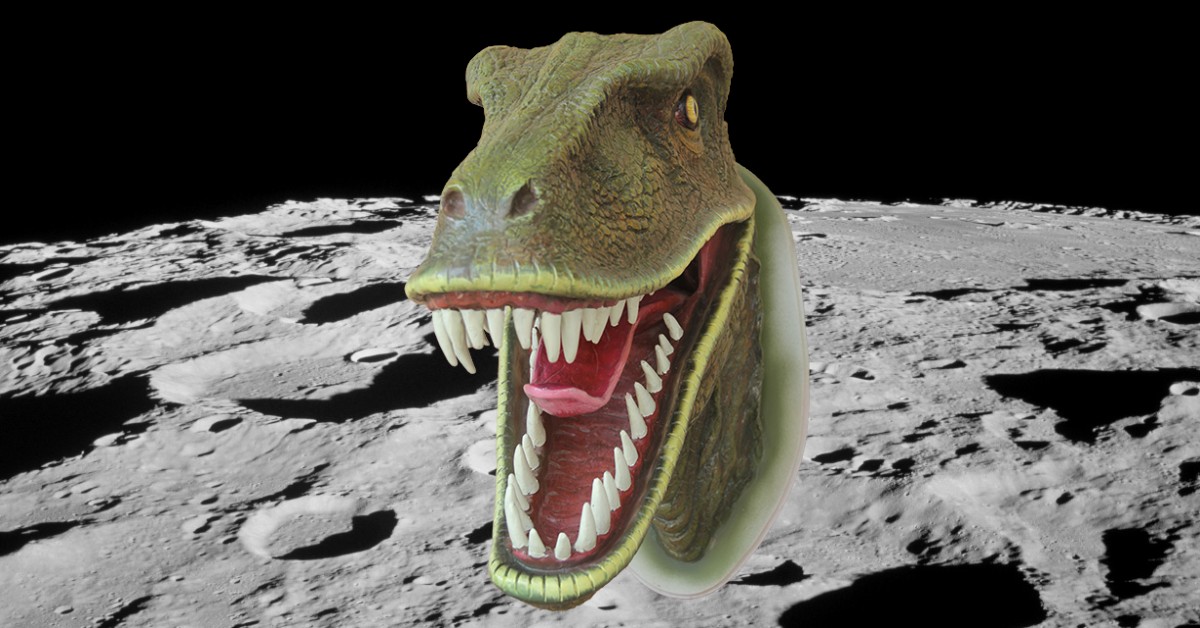Dinosaurs up there? Yes, indeed.

What astrophysicists have known for a long time probably comes as a big surprise for most of us: thanks to a (glorious) piece of science writing circulating online over the last couple of days, we are now being confronted with the shocking information that there are most likely tiny chunks of dinosaur sitting up there on the Moon.
Wait, what? Dinosaur remains on the Moon?
Yes, you’ve read that right. Some sixty-five million years before Neil Armstrong took that “one small step for man, one giant leap for mankind”, dinosaurs made it to Earth’s only proper natural satellite, alas involuntarily. No, they weren’t exactly planning to spray themselves across it like water from a ruptured hose. Or a ruptured planet, to be more precise. But that’s actually what happened.
Yes, by now you’ve probably guessed it, their version of space travel involved hitching a lift on the debris caused by the asteroid that wiped them out.

In his recent book, The Ends of the World, Peter Brannen takes a crack at explaining just how big the meteorite was and how quickly the event occurred.
“The meteorite itself was so massive that it didn’t notice any atmosphere whatsoever,” said Rebolledo. “It was traveling 20 to 40 kilometers per second, 10 kilometers — probably 14 kilometers — wide, pushing the atmosphere and building such incredible pressure that the ocean in front of it just went away.”
These numbers are precise without usefully conveying the scale of the calamity. What they mean is that a rock larger than Mount Everest hit planet Earth traveling twenty times faster than a bullet. This is so fast that it would have traversed the distance from the cruising altitude of a 747 to the ground in 0.3 seconds. The asteroid itself was so large that, even at the moment of impact, the top of it might have still towered more than a mile above the cruising altitude of a 747. In its nearly instantaneous descent, it compressed the air below it so violently that it briefly became several times hotter than the surface of the sun.
“The pressure of the atmosphere in front of the asteroid started excavating the crater before it even got there,” Rebolledo said. “Them when the meteorite touched ground zero, it was totally intact. It was so massive that the atmosphere didn’t even make a scratch on it.”
Unlike the typical Hollywood CGI depictions of asteroid impacts, where an extraterrestrial charcoal briquette gently smolders across the sky, in the Yucatan it would have been a pleasant day one second and the world was already over by the next. As the asteroid collided with the earth, in the sky above it where there should have been air, the rock had punched a hole of outer space vacuum in the atmosphere. As the heavens rushed in to close this hole, enormous volumes of earth were expelled into orbit and beyond — all within a second or two of impact.
“So there’s probably little bits of dinosaur bone up on the moon,” I asked.
“Yeah, probably.”
If an asteroid hitting Earth is large and fast enough, the impact can cause debris to achieve escape velocity (11.2 kms/second) and eventually leave our planet’s atmosphere. While much of it will fall back on the planet, other pieces may escape the planet’s influence and head out into the Solar System, possibly putting them on collision courses with other planets.
Actually, as IFL Science notes, we have a lot of evidence of this happening: scientists have discovered at least 289 meteorites that made it from impacts on Mars all the way to Earth! What is more, many moons in our solar system, including our own, are believed to have been created by such gigantic impacts. And there’s even more to it: according to recent research, it may even be possible for microorganisms to survive the journey from Earth to other planets or vice versa. How? Hidden in rock.
So yes, with the earth and rock went dinosaur bones. It was the end of their world, so they got buried on the Moon, and probably on Mars too.
Sources: 1, 2, 3
